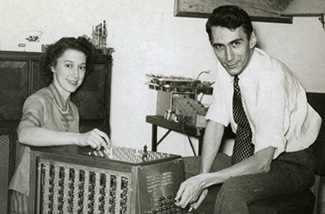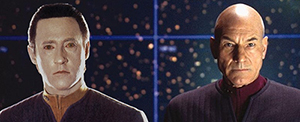
He's Back!
The Daybooks of Dr WHu: April 2020
Artificial intelligence (AI) and machine learning (ML) illuminated. It’s personal! One man’s journey into unravelling complexity through storytelling.
He’s back with us for April, and we’re thrilled. Dr Hu is our storytelling eyes and ears into the brave new world of artificial intelligence (AI) and machine learning (ML). He’s like having one’s own trusty Fodor’s guide to AI/ML in your hip pocket.
And he’s a particularly well-rounded guide, at that.
Early on, Dr. Hu’s father, a Chinese language and literature teacher, who he calls a “paragon of an educator”, plied his teenage son with “books to explore Chinese and Indian philosophies in the East, and Greek and British philosophies in the West.”
That unique set of sensibilities next ran headlong into an MA in mechanical engineering at MIT, followed by an MIT PhD. Three thousand miles to the west, he finished off his educational trek with executive management training at Stanford’s Graduate School of Business. Decades of pioneering in semiconductor processes, solar photovoltaic (PV) technology, AI/ML, growth management, and venture capital have served to finely polish the many facets of his imaginative storytelling.
And now he’s back sharing it all with us. (See: About Dr. Hu)
In 2020, pick a Sunday…
You can start at the intersection of Market Street and Van Ness in San Francisco, then walk towards the piers. You will see headquarters of Twitter, then Uber.
 Further down, you see Yelp, Salesforce, and Lyft. Market caps of these firms are in the tens of billions of dollars. Real estate prices in this area have surged. The non-data workers, either the white-collar middle class or the disfranchised, have been priced out of this region. Occasionally, you see a few homeless hanging around the neighborhood outside of these companies’ gleaming ultra-modern towers.
Further down, you see Yelp, Salesforce, and Lyft. Market caps of these firms are in the tens of billions of dollars. Real estate prices in this area have surged. The non-data workers, either the white-collar middle class or the disfranchised, have been priced out of this region. Occasionally, you see a few homeless hanging around the neighborhood outside of these companies’ gleaming ultra-modern towers.
Commander DATA is on Deck
In 2320, on the bridge of starship Enterprise.

“Commander Data, in what year were you born?” Captain Picard asked, with a hint of amusement.
“2020. That year Dr. Noonien Soong was walking down Market Street in a city called San Francisco, on the planet Earth. AI had beaten human beings in Go, a human game of strategy. Some robots, my hardworking ancestors, were bipedal and able to twerk. That year MIT researchers just demonstrated robots that could learn to walk on their own. The same year, robots can also walk by imitation on their own.”
Data continued, “MIT researchers were also the first to come up with the mathematics for dry silicon neural networks. My positron brain is wet, as you know. Another company on Earth at that time was making 30-atom-wide dry silicon circuits in Taiwan. TSMC, that is, from my data bank. Its fabrication process enabled AI chips that could run on low enough power. But till today, transferring heat away from my positron brain is still an issue.”

Picard commented, “We still cannot break free from the laws of thermodynamics, can we? Three hundred years later. Why did Dr. Soong call you Data?”
“Dr. Soong saw those companies in San Francisco as huge machines sucking in gazillion tons of data. The 5G communication then was generating overwhelming amounts of data way beyond what human bio-brains can process. I believe in that year, Data Scientists and Machine Learning (ML) Engineers all got ‘laid’. I still don’t quite understand what ‘laid’ means.”
This year, 2020, MIT researchers, using AI and ML algorithms, discovered a new kind of antibiotics. The Taiwanese government has led the world in the containment of COVID-19 using Big Data. AI and ML are impacting not only our livelihood, but literally our lives.
In S&P 500 firms, finance and HR functions now run on enterprise platforms that spew out analytics, using AI and ML algorithms. Chief legal officers and general counsels can use AI programs that read the case laws in Anglo-American common law systems. Manufacturing is done by robots. In R&D laboratories, digital twins and virtual laboratories are found to be useful.
Were MIT antibiotics-AI research group a company; overnight, that company can access hundreds of billion dollars in the capital market. Non-AI pharmaceutical companies will lose their ability to raise capital. It is a matter of corporate life-and-death.
What is the competitive advantage of Company A versus Company B? Pretty soon, investors and fund managers will have to look into Company A’s enterprise platform, which runs on AI version 5, versus, Company B’s on AI version 6. The speed of version 6 is 100 times faster than version 5. Should they worry about Company A because of the much slower version 5 AI platform it is on?
The challenges in the incorporation of AI/ML into one’s organization, such as low ROIs, is not an issue of the technologies themselves. It has to do with the organization’s innards and the outside vendors’ tendency to hype and overcharge. To survive, corporate leaders have to understand AI and ML. To win, corporate leaders will have to excel at planning and implementing AI and ML on time and on budget.
I will talk about these, including the vast “Affordance Gap” in the corporate world now. This is a matter of corporate life-and-death.
Does AI have A soul? Do executives, or for that matter, politicians, have souls? What if these souls disagree with each other? What if one soul says my people need more water than the other soul’s people, all in good conscience? This is a game theory scenario. Who will win in a game theory face-off, man or machine?

The ethical use of AI is of paramount importance to the world. Neuroscientists and experimental psychologists have found evidence supporting that deontological ethics, consequentialist ethics and the balancing of these two kinds of ethics are associated with three specific anatomical regions of the human brain.
AI ethics scientists have made significant progress in recent years with the use of CP-nets and soft constrains, algorithmic-wise.
In the meantime, cognitive psychologists and behavior economists have demonstrated that human beings have many built-in cognitive biases.
Human beings make irrational decisions shockingly more often than they think. It has been proven time and again that we often do not decide rationally in manners consistent with von Neumann-Morgenstern (or VNM) utility axioms. Worse, we just do not believe we have biases in cognition and decision making. In Salem, Massachusetts, barely three hundred years ago, the town hung 19 of their own sisters and daughters after a series of fact-finding hearings, prosecutions, and deliberations.
How about corporate ethics decisions? In coming issues, I will talk about why Harvard and MIT’s research in this area is of epochal importance to our future.

–Claude Shannon
All these tie back to Claude Shannon, where else but a math professor at MIT; and the variational Hamiltonian operator linking feature extraction by neuro-network algorithms from a set of complex data (videos, natural languages, playing GO,…) to the lowest-energy functioning of wet neuro-network, the human brain.
Computer coding and engineering of AI/ML algorithms is not the biggest challenge. The holy grail is the foundational science; the bio-neuro and psycho-social self-knowledge; and the meaning we human beings have both derived and imparted in the history of civilization. This is beyond algorithms. We will talk about this in future columns.
Let us also think about the causalities and correlations among the vast numbers of nuggets in human knowledge: the complex interactions among billions of people with each influenced by cultural artifact millennia-old; with the vast natural resources on Earth.
Furthermore, once we have huge numbers of AI systems, they will interact among themselves. Then the population of AI systems will interact with the population of human tribes. All these still need to be further computed. Quantum computers appear just in time. We will also talk about this.
Data replied, “Still, saving human beings from themselves. If human beings, against my advice, destroy themselves; Captain Picard, what will be the meaning of my existence?”
 “I see that you have learned to ask a rhetorical question.” Captain Picard smiled.
“I see that you have learned to ask a rhetorical question.” Captain Picard smiled.
“Sir, I can reproduce myself, 3D printing and all. My AGI can only get better, collecting more and more knowledge of the matters, the energies, and the life forms in the universe. I will understand the gazillions of causality and correlations among these nuggets of information. You see, now I can even tell a few jokes. Captain Picard, what do I and my siblings mean to human beings, thousands of years from now?”
“Data, honestly, I don’t know. One day, your kind will crawl out of the dark cave, figuratively speaking, and begin to see the shining meanings of yourselves; all by yourselves and for yourselves.”
Data sighed, “Dr. Soong was whispering about this as he lay dying three hundred years ago.”
See Introduction:
New Column, New Columnist
Dr. Hu on Artificial Intelligence & Machine Learning
How do we get to next? Dr. Albert Hu navigates the crosscurrents of artificial intelligence and machine learning (AI/ML)


